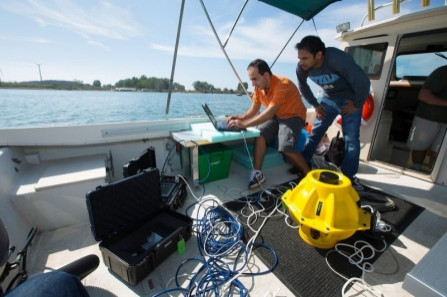Scientists Develop Underwater Wireless Internet For ‘Deep-Sea’ Communication

You can hardly walk through a café, subway station or even a public park without picking up WiFi on your smartphone. Almost anywhere you turn, there’s a wireless Internet network to greet you. But there’s one spot the mobile Web can’t go: underwater.
Water poses a problem for wireless Internet, which employs almost the same technology as walkie-talkies, cell phones and other mobile devices to convert the 1s and 0s of computer code into radio waves. Radio waves travel poorly through water, UCSB’s ScienceLine noted, especially at the frequency the Internet requires.
While very low frequency radio waves – waves with a frequency between 3 and 30 kilohertz – are used in submarine communication systems, Internet radio waves have to transmit at frequencies of 2.4 gigahertz or 5 gigahertz in order to accommodate larger data, according to How Stuff Works.
A prime example of the limitations of underwater communications is the robotic vehicle sent down to explore the wreckage of the Titanic. The vehicle needed a very heavy and expensive cable attached to it in order to communicate with a boat 12,500 feet, or about 2.4 miles, above it.
Researchers from the University of Buffalo are developing a way to wirelessly transmit the Internet underwater. According to Phys.org, they recently tested a system in Lake Erie, just south of downtown Buffalo, N.Y. They submerged two 40-pound sensors into the water, and then communicated with them wirelessly through a laptop.
“A submerged wireless network will give us an unprecedented ability to collect and analyze data from our oceans in real time," Tommaso Melodia, a University of Buffalo associate professor of electrical engineering and the project’s lead researcher, said in a press release on the university’s website. “Making this information available to anyone with a smartphone or computer, especially when a tsunami or other type of disaster occurs, could help save lives.”
Current underwater communication technology, like that used by the Navy and National Oceanic and Atmospheric Administration, or NOAA, relies on sound waves.
NOAA’s tsunami sensors, for example, located on the sea floor transmit information to buoys on the surface through the use of acoustic waves. Technology on the buoy then turns that information into radio waves.
The university’s research is funded by the National Science Foundation, a U.S. government agency that sponsors research in non-medical fields of science and engineering, including the recently shuttered Antarctic research program.
The reason for developing underwater wireless Internet isn’t so you can scuba dive and shop Amazon at the same time. Researchers hope that by improving underwater communication, they can make improvements in tsunami detection, pollution monitoring and offshore oil and natural gas exploration.
© Copyright IBTimes 2024. All rights reserved.






















